Impact of Assimilating Conventional Observations on Short-Term Nearshore Wind Forecast over the East China Sea
Abstract
1. Introduction
2. Methodology
2.1. The Numerical Model
2.2. Experimental Setup and Verification
3. Characteristics of Nearshore Wind Field
4. Forecast Verification
5. Conclusions and Discussion
Author Contributions
Funding
Institutional Review Board Statement
Informed Consent Statement
Data Availability Statement
Conflicts of Interest
References
- Adams, F.G.; Shachmurove, Y. Modeling and forecasting energy consumption in China: Implications for Chinese energy demand and imports in 2020. Energy Econ. 2008, 30, 1263–1278. [Google Scholar] [CrossRef]
- Fan, Y.; Xia, Y. Exploring energy consumption and demand in China. Energy 2012, 40, 23–30. [Google Scholar] [CrossRef]
- Kritharas, P.P.; Watson, S.J. A Comparison of Long-Term Wind Speed Forecasting Models. J. Sol. Energy Eng. Trans. ASME 2010, 132, 041008. [Google Scholar] [CrossRef]
- Alessandrini, S.; Sperati, S.; Pinson, P. A comparison between the ECMWF and COSMO Ensemble Prediction Systems applied to short-term wind power forecasting on real data. Appl. Energy 2013, 107, 271–280. [Google Scholar] [CrossRef]
- Santhosh, M.; Venkaiah, C.; Kumar, D.M.V. Current advances and approaches in wind speed and wind power forecasting for improved renewable energy integration: A review. Eng. Rep. 2020, 2, 1–20. [Google Scholar] [CrossRef]
- Wu, Y.-K.; Hong, J.-S. A Literature Review of Wind Forecasting Technology in the World. In Proceedings of the 2007 IEEE Lausanne Power Tech, Lausanne, Switzerland, 1–5 July 2007; pp. 504–509. [Google Scholar]
- Hong, Y.-Y.; Rioflorido, C.L.P.P. A hybrid deep learning-based neural network for 24-h ahead wind power forecasting. Appl. Energy 2019, 250, 530–539. [Google Scholar] [CrossRef]
- Carpinone, A.; Giorgio, M.; Langella, R.; Testa, A. Markov chain modeling for very-short-term wind power forecasting. Electr. Power Syst. Res. 2015, 122, 152–158. [Google Scholar] [CrossRef]
- Sandeepan, B.S.; Panchang, V.G.; Nayak, S.; Kumar, K.K.; Kaihatu, J.M. Performance of the WRF Model for Surface Wind Prediction around Qatar. J. Atmospheric Ocean. Technol. 2018, 35, 575–592. [Google Scholar] [CrossRef]
- Zhang, H.; Pu, Z.; Zhang, X. Examination of Errors in Near-Surface Temperature and Wind from WRF Numerical Simulations in Regions of Complex Terrain. Weather. Forecast. 2013, 28, 893–914. [Google Scholar] [CrossRef]
- Fernández-González, S.; Martín, M.L.; García-Ortega, E.; Merino, A.; Lorenzana, J.; Sanchez, J.L.; Valero, F.; Rodrigo, J.S. Sensitivity Analysis of the WRF Model: Wind-Resource Assessment for Complex Terrain. J. Appl. Meteorol. Clim. 2018, 57, 733–753. [Google Scholar] [CrossRef]
- Siuta, D.; West, G.; Stull, R. WRF Hub-Height Wind Forecast Sensitivity to PBL Scheme, Grid Length, and Initial Condition Choice in Complex Terrain. Weather. Forecast. 2017, 32, 493–509. [Google Scholar] [CrossRef]
- Huang, H.-Y.; Hall, A.; Teixeira, J. Evaluation of the WRF PBL Parameterizations for Marine Boundary Layer Clouds: Cumulus and Stratocumulus. Mon. Weather Rev. 2013, 141, 2265–2271. [Google Scholar] [CrossRef][Green Version]
- Svensson, N.; Arnqvist, J.; Bergström, H.; Rutgersson, A.; Sahlée, E. Measurements and Modelling of Offshore Wind Profiles in a Semi-Enclosed Sea. Atmosphere 2019, 10, 194. [Google Scholar] [CrossRef]
- Case, J.L.; Wheeler, M.M.; Manobianco, J.; Weems, J.W.; Roeder, W.P. A 7-Yr Climatological Study of Land Breezes over the Florida Spaceport. J. Appl. Meteorol. 2005, 44, 340–356. [Google Scholar] [CrossRef]
- Tang, X.; Sun, J.; Zhang, Y.; Tong, W. Constraining the Large-Scale Analysis of a Regional Rapid-Update-Cycle System for Short-Term Convective Precipitation Forecasting. J. Geophys. Res. Atmos. 2019, 124, 6949–6965. [Google Scholar] [CrossRef]
- Zheng, M.; Monache, L.D.; Wu, X.; Ralph, F.M.; Cornuelle, B.; Tallapragada, V.; Haase, J.S.; Wilson, A.M.; Mazloff, M.; Subramanian, A.; et al. Data Gaps within Atmospheric Rivers over the Northeastern Pacific. Bull. Am. Meteorol. Soc. 2021, 102, E492–E524. [Google Scholar] [CrossRef]
- Skamarock, W.C.; Klemp, J.B.; Dudhi, J.; Gill, D.O.; Barker, D.M.; Duda, M.G.; Huang, X.-Y.; Wang, W.; Powers, J.G. A Description of the Advanced Research WRF Version 3; NCAR: Boulder, CO, USA, 2008. [Google Scholar]
- Barker, D.M.; Huang, W.; Guo, Y.-R.; Bourgeois, A.J.; Xiao, Q.N. A Three-Dimensional Variational Data Assimilation System for MM5: Implementation and Initial Results. Mon. Weather Rev. 2004, 132, 897–914. [Google Scholar] [CrossRef]
- Kain, J.S.; Fritsch, J.M. Convective Parameterization for Mesoscale Models: The Kain-Fritsch Scheme. In The Representation of Cumulus Convection in Numerical Models; American Meteorological Society: Boston, MA, USA, 1993; Volume 24, pp. 165–170. ISBN 978-1-935704-13-3. [Google Scholar]
- Hong, S.; Lim, J. The WRF Single-Moment 6-Class Microphysics Scheme (WSM6). J. Korean Meteorol. Soc. 2006, 42, 129–151. [Google Scholar]
- Janjic, Z. Nonsingular Implementation of the Mellor-Yamada Level 2.5 Scheme in the NCEP Meso Model. NCEP Off. Note 2002, 437, 61. [Google Scholar]
- Ek, M.B.; Mitchell, K.E.; Lin, Y.; Rogers, E.; Grunmann, P.; Koren, V.; Gayno, G.; Tarpley, J.D. Implementation of Noah land surface model advances in the National Centers for Environmental Prediction operational mesoscale Eta model. J. Geophys. Res. Atmos. 2003, 108, 8851. [Google Scholar] [CrossRef]
- Iacono, M.J.; Delamere, J.S.; Mlawer, E.J.; Shephard, M.W.; Clough, S.A.; Collins, W.D. Radiative forcing by long-lived greenhouse gases: Calculations with the AER radiative transfer models. J. Geophys. Res. Atmos. 2008, 113, D13103. [Google Scholar] [CrossRef]
- O’Neill, L.W.; Chelton, D.B.; Esbensen, S.K. The Effects of SST-Induced Surface Wind Speed and Direction Gradients on Midlatitude Surface Vorticity and Divergence. J. Clim. 2010, 23, 255–281. [Google Scholar] [CrossRef]
- Perlin, N.; de Szoeke, S.P.; Chelton, D.B.; Samelson, R.M.; Skyllingstad, E.D.; O’Neill, L.W. Modeling the Atmospheric Boundary Layer Wind Response to Mesoscale Sea Surface Temperature Perturbations. Mon. Weather Rev. 2014, 142, 4284–4307. [Google Scholar] [CrossRef]
- Draxl, C.; Hahmann, A.N.; Peña, A.; Giebel, G. Evaluating winds and vertical wind shear from Weather Research and Forecasting model forecasts using seven planetary boundary layer schemes. Wind. Energy 2014, 17, 39–55. [Google Scholar] [CrossRef]
- Sun, J.; Wang, H.; Tong, W.; Zhang, Y.; Lin, C.-Y.; Xu, D. Comparison of the Impacts of Momentum Control Variables on High-Resolution Variational Data Assimilation and Precipitation Forecasting. Mon. Weather. Rev. 2016, 144, 149–169. [Google Scholar] [CrossRef]
- Kalnay, E. Atmospheric Modeling, Data Assimilation and Predictability; Cambridge University Press: Cambridge, UK, 2002; ISBN 0521796296. [Google Scholar]
- Parrish, D.F.; Derber, J.C. The National Meteorological Center’s Spectral Statistical-Interpolation Analysis System. Mon. Weather Rev. 1992, 120, 1747–1763. [Google Scholar] [CrossRef]
- Ha, J.-H.; Lee, D.-K. Effect of length scale tuning of background Error in WRF-3DVAR system on assimilation of high-resolution surface data for heavy rainfall simulation. Adv. Atmospheric Sci. 2012, 29, 1142–1158. [Google Scholar] [CrossRef]
- Tong, W.; Sun, J.; Tang, X.; Zhang, Y. Design Strategies of an Hourly Update 3DVAR Data Assimilation System for Improved Convective Forecasting. Weather. Forecast. 2016, 31, 1673–1695. [Google Scholar] [CrossRef]
- Huang, M.; Gao, Z.; Miao, S.; Xu, X. Characteristics of sea breezes over the Jiangsu coastal area, China. Int. J. Clim. 2016, 36, 3908–3916. [Google Scholar] [CrossRef]
- Zhuang, Y.; Tang, X.; Wang, Y. Impact of track forecast error on tropical cyclone quantitative precipitation forecasts over the coastal region of China. J. Hydrol. 2020, 589, 125347. [Google Scholar] [CrossRef]
- Dee, D.P. Bias and data assimilation. Q. J. R. Meteorol. Soc. 2005, 131, 3323–3343. [Google Scholar] [CrossRef]




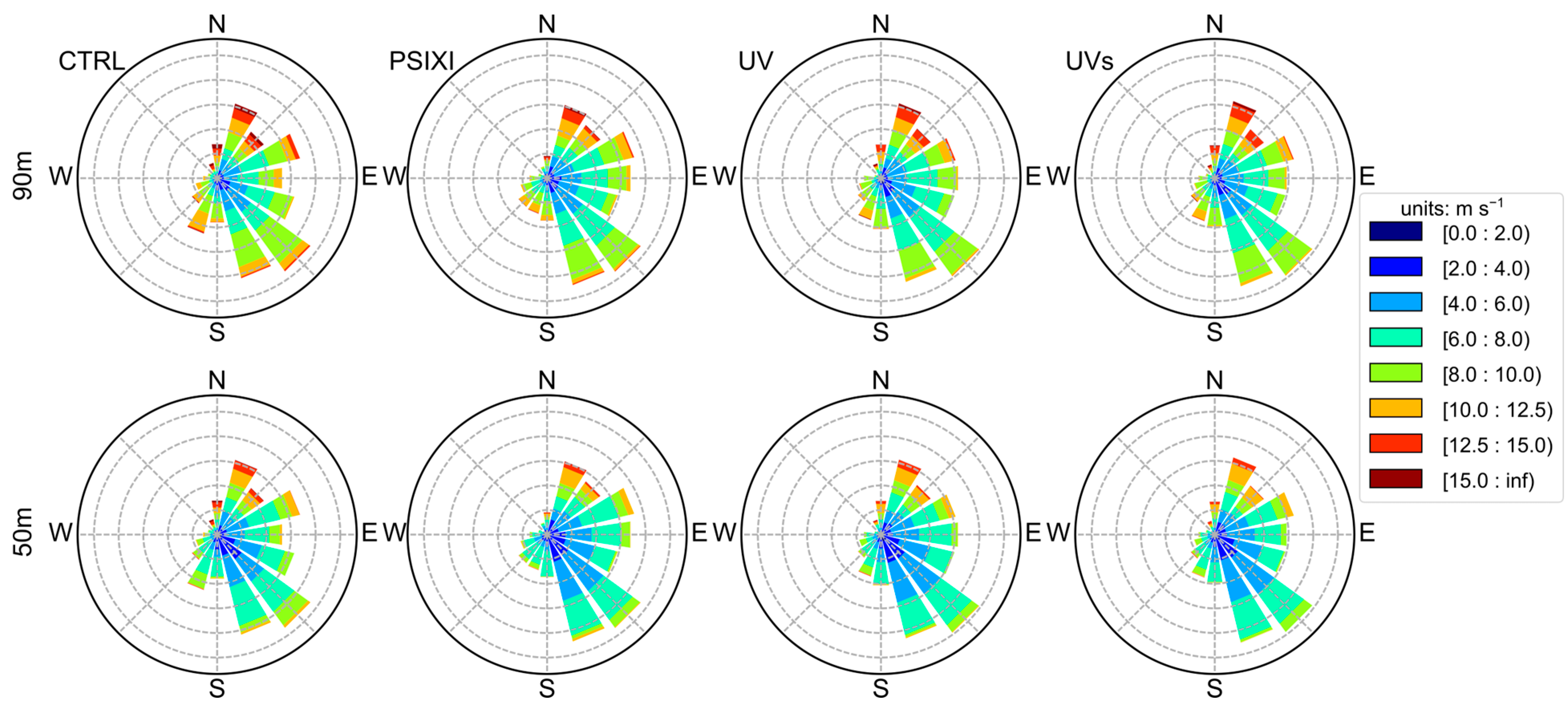
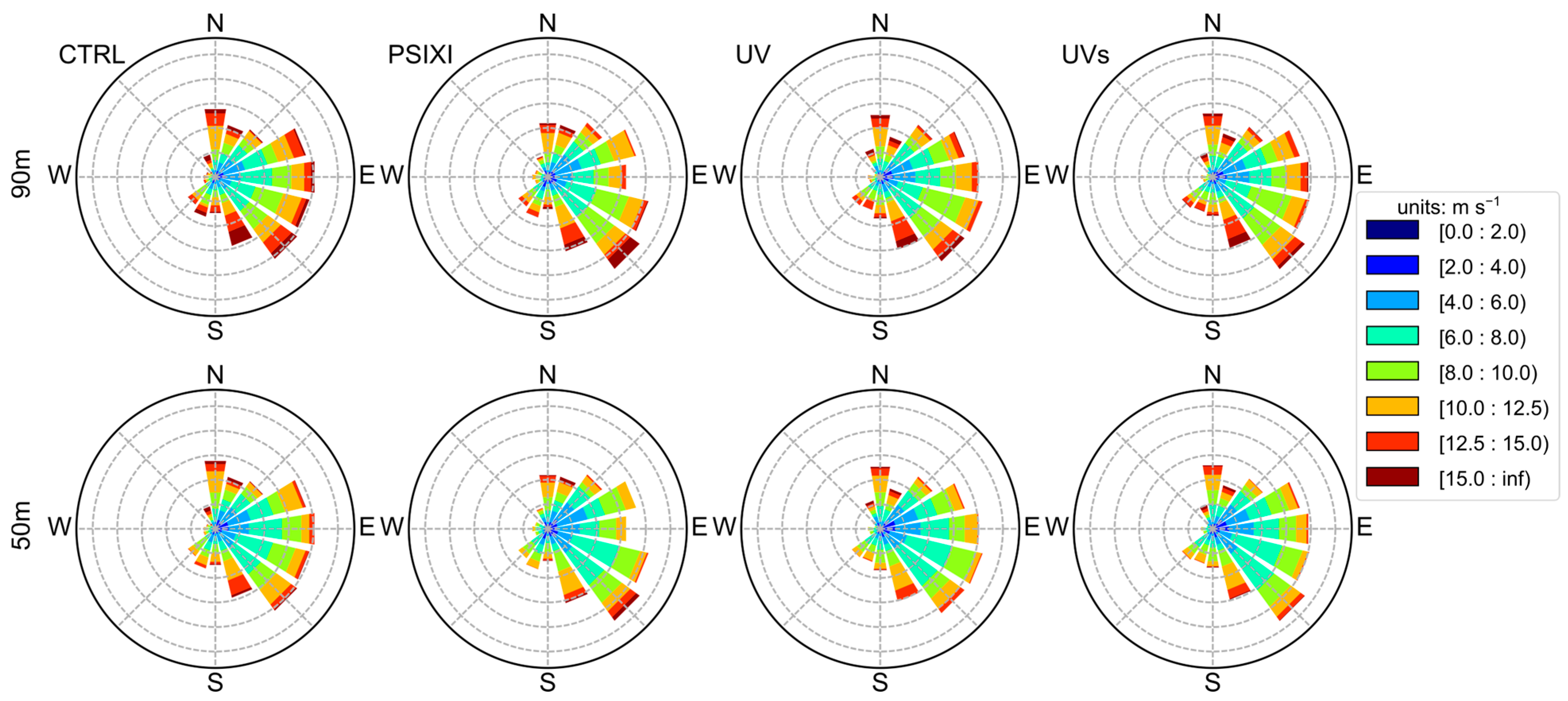
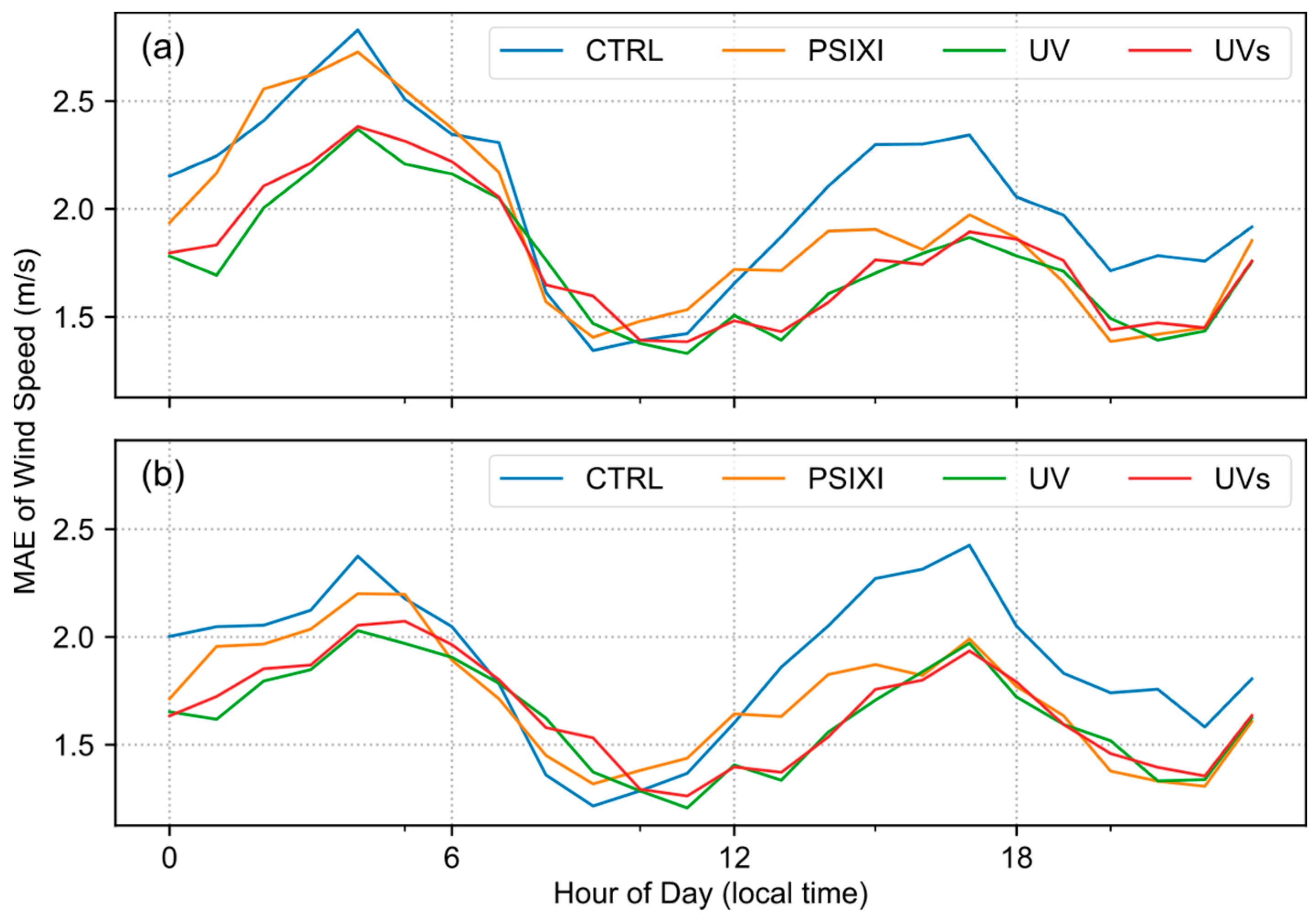
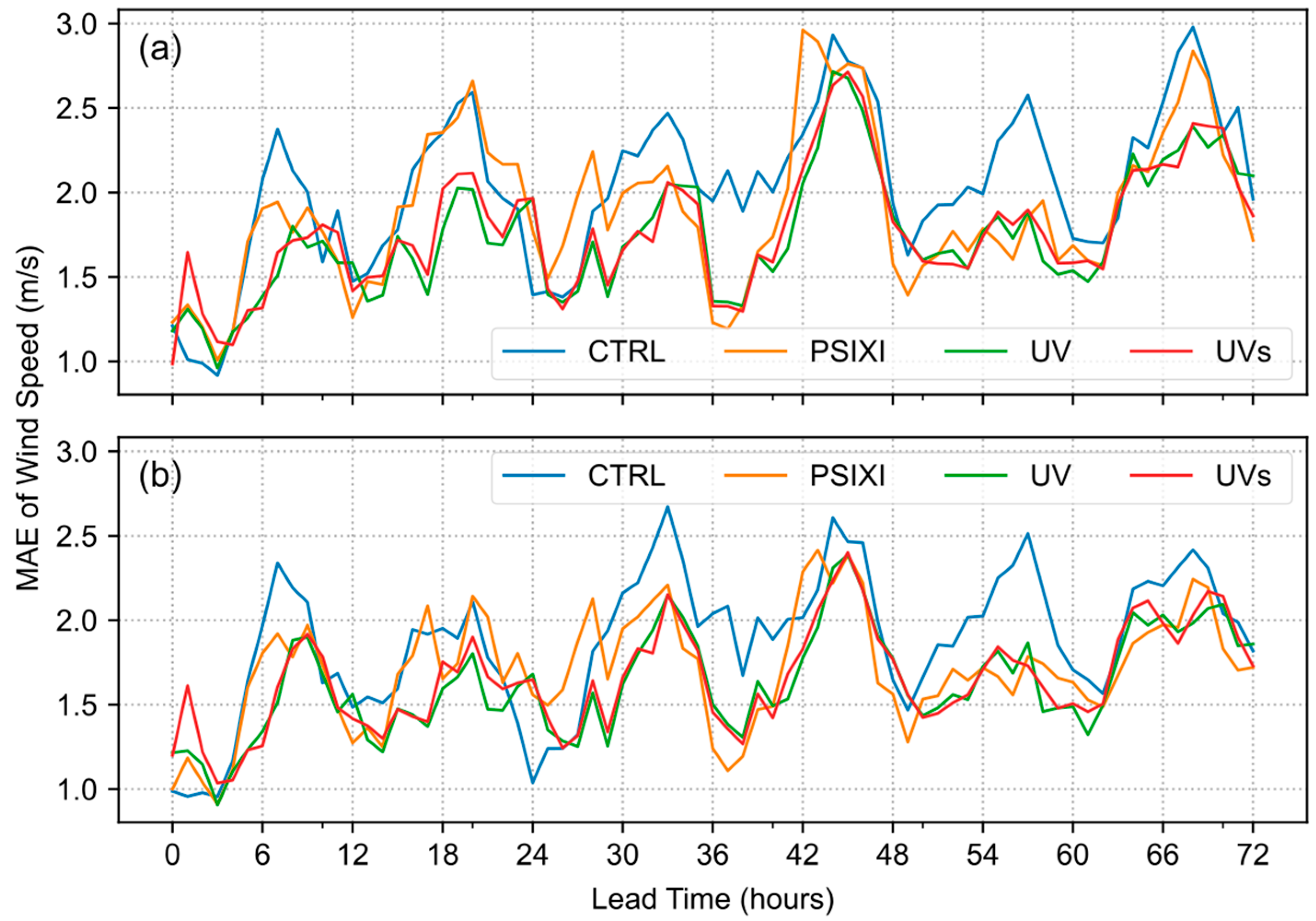

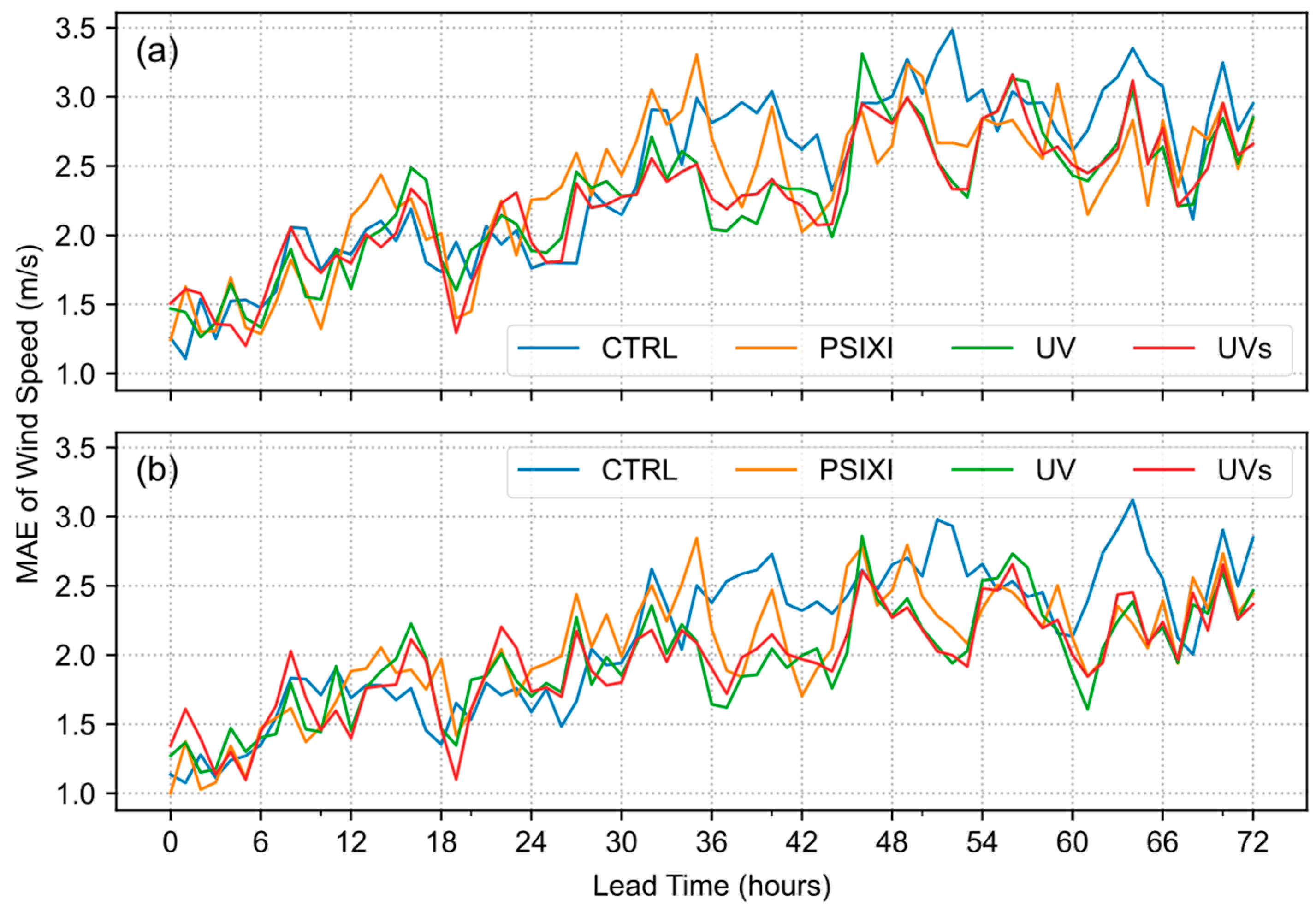

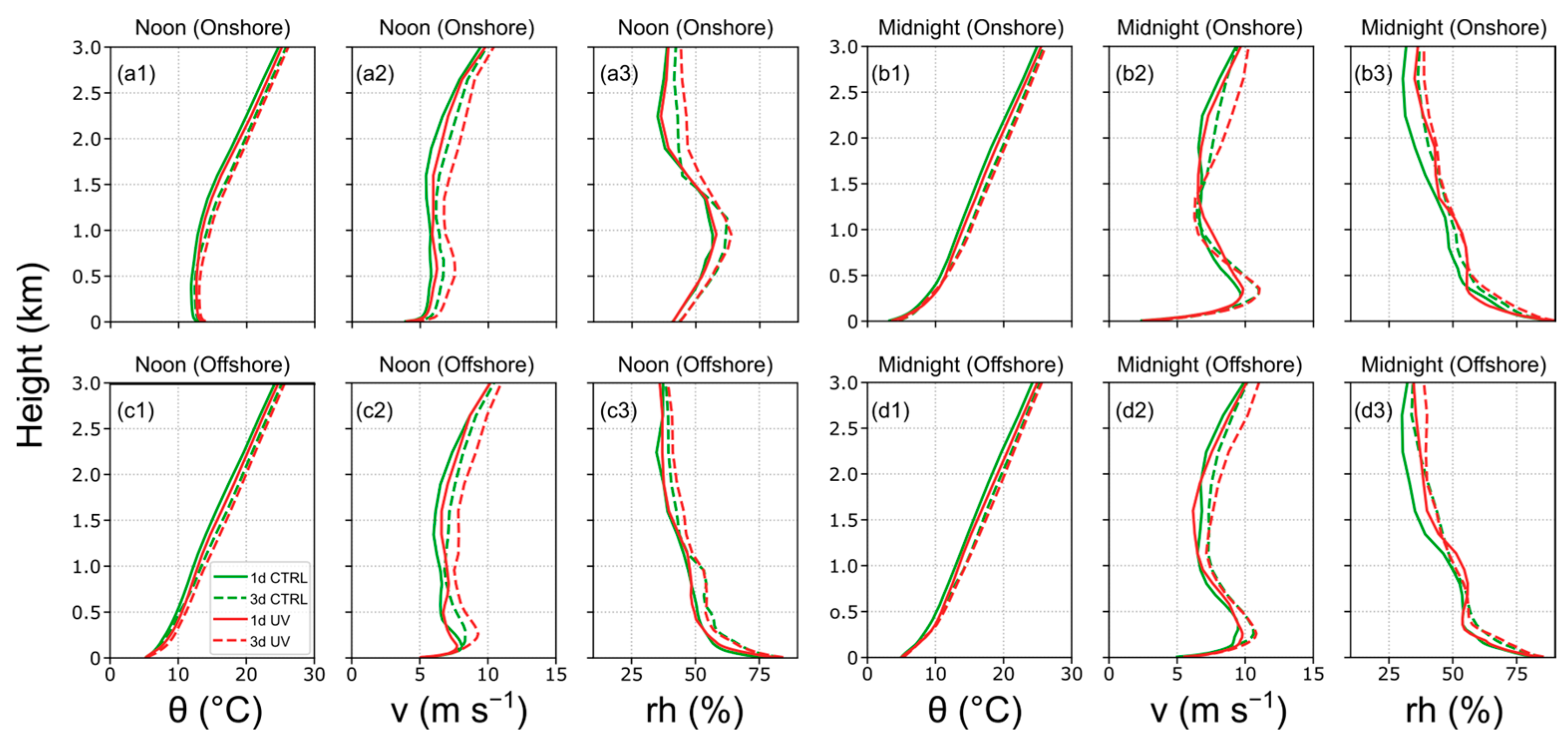

| Name | Control Variable | CV Option | Variance Scale | Length Scale |
|---|---|---|---|---|
| CTRL | / | / | / | / |
| PSIXI | ψχ | 5 | 1 | 1 |
| UV | uv | 7 | 1 | 1 |
| UVs | uv | 7 | 1.5 | 0.5 |
| Mast | Exp | BIAS | MAE | MAPE | |||
|---|---|---|---|---|---|---|---|
| 50 m | 90 m | 50 m | 90 m | 50 m | 90 m | ||
| #1 | CTRL | 1.3 | 1.35 | 1.87 | 2.03 | 0.54 | 0.45 |
| PSIXI | 0.85 | 0.85 | 1.71 | 1.91 | 0.51 | 0.44 | |
| UV | 0.88 | 0.88 | 1.63 | 1.74 | 0.50 | 0.41 | |
| UVs | 0.9 | 0.9 | 1.66 | 1.78 | 0.52 | 0.42 | |
| #4 | CTRL | 2.58 | 2.67 | 2.80 | 2.95 | 0.49 | 0.51 |
| PSIXI | 1.93 | 1.99 | 2.32 | 2.50 | 0.47 | 0.49 | |
| UV | 2.08 | 2.14 | 2.30 | 2.46 | 0.46 | 0.48 | |
| UVs | 2.05 | 2.11 | 2.31 | 2.45 | 0.46 | 0.48 | |
Disclaimer/Publisher’s Note: The statements, opinions and data contained in all publications are solely those of the individual author(s) and contributor(s) and not of MDPI and/or the editor(s). MDPI and/or the editor(s) disclaim responsibility for any injury to people or property resulting from any ideas, methods, instructions or products referred to in the content. |
© 2022 by the authors. Licensee MDPI, Basel, Switzerland. This article is an open access article distributed under the terms and conditions of the Creative Commons Attribution (CC BY) license (https://creativecommons.org/licenses/by/4.0/).
Share and Cite
Dong, X.; Tang, X.; Tang, J.; Zhao, S.; Lu, Y.; Chen, X. Impact of Assimilating Conventional Observations on Short-Term Nearshore Wind Forecast over the East China Sea. Atmosphere 2023, 14, 47. https://doi.org/10.3390/atmos14010047
Dong X, Tang X, Tang J, Zhao S, Lu Y, Chen X. Impact of Assimilating Conventional Observations on Short-Term Nearshore Wind Forecast over the East China Sea. Atmosphere. 2023; 14(1):47. https://doi.org/10.3390/atmos14010047
Chicago/Turabian StyleDong, Xue, Xiaowen Tang, Jiajia Tang, Shengxiao Zhao, Yanyan Lu, and Xiaofeng Chen. 2023. "Impact of Assimilating Conventional Observations on Short-Term Nearshore Wind Forecast over the East China Sea" Atmosphere 14, no. 1: 47. https://doi.org/10.3390/atmos14010047
APA StyleDong, X., Tang, X., Tang, J., Zhao, S., Lu, Y., & Chen, X. (2023). Impact of Assimilating Conventional Observations on Short-Term Nearshore Wind Forecast over the East China Sea. Atmosphere, 14(1), 47. https://doi.org/10.3390/atmos14010047






